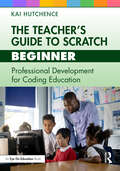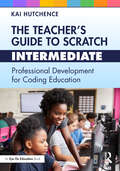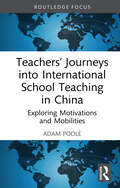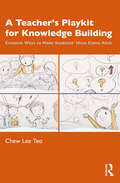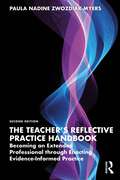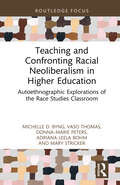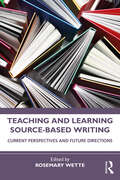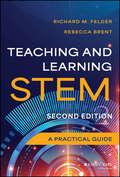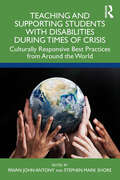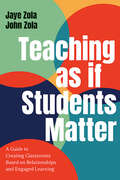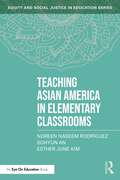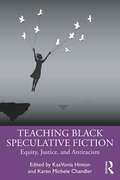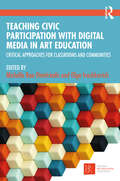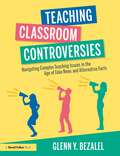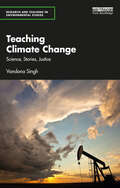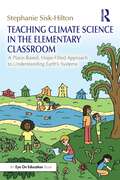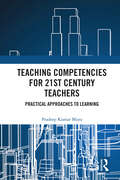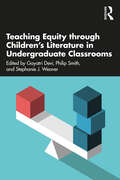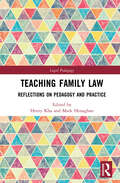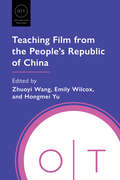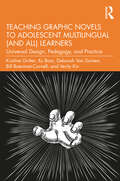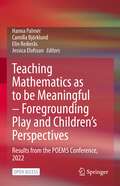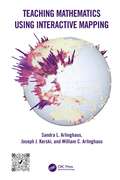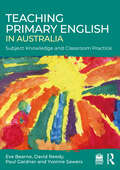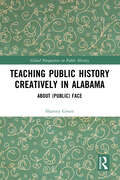- Table View
- List View
The Teacher’s Guide to Scratch – Beginner: Professional Development for Coding Education
by Kai HutchenceThe Teacher’s Guide to Scratch – Beginner is a practical guide for educators preparing beginners-level coding lessons and assignments in their K–12 classrooms. The world’s largest and most active visual programming platform, Scratch helps today’s schools answer the growing call to realize important learning outcomes using coding and computer science. This book illustrates the benefits and fundamental building blocks of Scratch coding, details effective pedagogical strategies and learner collaborations, and offers actionable, accessible troubleshooting tips. Geared toward the fledgling user, these four unique coding projects will provide the technical training that teachers need to feel comfortable and confident in their skills and to help instill the same feeling of accomplishment in their students. Clear goals, a comprehensive glossary, and other features ensure the project’s enduring relevance as a reference work for computer science education in grade school. Thanks to Scratch’s cost-effective open-source license, suitability for blended and project-based learning, notable lack of privacy or security risks, and consistency in format even amid software and interface updates, this will be an enduring practitioner manual and professional development resource for years to come.
The Teacher’s Guide to Scratch – Intermediate: Professional Development for Coding Education
by Kai HutchenceThe Teacher’s Guide to Scratch – Intermediate is a practical guide for educators preparing moderately complex coding lessons and assignments in their K-12 classrooms. The world’s largest and most active visual programming platform, Scratch helps today’s schools answer the growing call to realize important learning outcomes using coding and computer science. This book illustrates the increasingly intricate affordances of Scratch coding, details effective pedagogical strategies and learner collaborations, and offers actionable, accessible troubleshooting tips. Geared toward the intermediate user, these four unique coding projects will provide the technical training that teachers need to feel comfortable and confident in their skills and to help instill the same feeling of accomplishment in their students. Clear goals, a comprehensive glossary, and other features ensure the project’s enduring relevance as a reference work for computer science education in grade school. Thanks to Scratch’s cost-effective open-source license, suitability for blended and project-based learning, notable lack of privacy or security risks, and consistency in format even amid software and interface updates, this will be an enduring practitioner manual and professional development resource for years to come.
Teachers’ Journeys into International School Teaching in China: Exploring Motivations and Mobilities (Routledge Series on Schools and Schooling in Asia)
by Adam PoolePoole’s book illuminates the experiences and perspectives of host country national teachers at internationalised schools in China. The international school sector in China has undergone significant changes in recent years. This is due to the growing demand for international education from local middle-class families. In response, a new type of school has emerged. Going by various names, such as private, bilingual or internationalised, these schools offer a fusion of national and international curricula and are staffed predominantly by host country national teachers. Despite these changes, we still know little about who host country national teachers are and what draws them to the world of international schooling. Accordingly, this book explores the motivations and mobilities of host country national teachers in China. It identifies three types of teacher: Returners, Reachers, and Remainers. Returners are graduates who have returned to China from overseas study. They are drawn to international schools by the opportunity to use their international experience and qualification. Reachers are internal migrants who face structural inequality and attracted to international schools by the opportunity for social mobility. Remainers are married teachers with children. They are motivated to work in international schools by the perceived stability and security these schools offer. Discussing implications for teacher recruitment, development, and retention in international schools, this book is an essential read for international educational researchers as well as students researching international education or teacher identity.
A Teacher’s Playkit for Knowledge Building: Creative Ways to Make Students’ Ideas Come Alive
by Chew Lee TeoDelving into the journey of teachers and students in the knowledge building classroom, Teo’s playkit offers practical approaches to making classrooms a place of knowledge creation.Teo highlights the potential and possibility of idea-centric discourse and interactions in Singapore’s high-performing education system while offering a trilogue among researchers, teachers and students: the agents of a knowledge building environment in classrooms. Documenting case examples of knowledge building lessons in relation to the curriculum design and pedagogical decisions and moves, as well as the formative assessment, the book focuses on those 21st-century practices embedded within the knowledge building process. It comprises a series of teachers’ journeys in different subjects and grades, demonstrating the depth and breadth of projects that students are capable of pursuing in class when they are entrusted to work with their own ideas and questions. It also offers a collection of concrete tools and strategies for teachers to use to support knowledge building work. The different case examples support teachers in their design effort and will encourage the community of researchers and educators to continue to imagine the possibilities of pedagogical educational reform.Written for practitioners, this playkit aims to engage the wider community of teachers to play with their own lesson ideas as they engage their students in knowledge creation.
The Teacher's Reflective Practice Handbook: Becoming an Extended Professional through Enacting Evidence-Informed Practice
by Paula Nadine Zwozdiak-MyersThe Teacher’s Reflective Practice Handbook is based on a multi-dimensional framework of reflective practice designed by the author to guide and support student, early career and experienced teachers to develop high-quality teaching and maximise pupil learning. This second edition combines the intent to preserve the integrity of seminal contributions advanced by eminent scholars and practitioners over the years, with that of broadening its reach to reflect key changes in policy discourse, teacher education, school and curriculum reform underpinned by evidence-informed research on what constitutes effective teaching and learning, across the national and international landscape. Chapters invite you to engage in descriptive, comparative and critical reflective conversations across nine dimensions of reflective practice which enables you to: Question personal theories, beliefs and assumptions about teaching and consider alternative perspectives and possibilities Systematically evaluate your own teaching through classroom research procedures Try out new strategies and ideas to appropriate new knowledge and to tailor inclusive provision for all your learners Enhance the quality of and continue to improve your own teaching Including a range of reflective tasks, links to online resources, exemplification material and further reading to develop and challenge your own thinking, The Teacher’s Reflective Practice Handbook is an essential and accessible guide which supports the enactment of reflective practice through self- and peer-assessment, solution-focused learning, professional development and improvement planning to build a meaningful portfolio of evidence-informed practice.
Teaching and Confronting Racial Neoliberalism in Higher Education: Autoethnographic Explorations of the Race Studies Classroom (Routledge Research in Race and Ethnicity in Education)
by Michelle D. Byng Vaso Thomas Donna-Marie Peters Adriana Leela Bohm Mary StrickerThis book examines the way in which professors must confront the social implications of racial neoliberalism. Drawing on autoethnographic research from the authors’ combined 100 years of teaching experience, it recognizes the need for faculty to negotiate their own experiences with race, as well as those of their students. It focuses on the experiential nature of teaching, supplementing the fields’ focus on pedagogy, and recognizes that professors must, in fact, highlight, rather than downplay, the realities of racial inequalities of the past and present. It explores the ability of instructors to make students who are not of color feel that they are not racists, as well as their ability to make students of color feel that they can present their experiences of racism as legitimate. A unique sociological analysis of the racial studies classroom, this book will be of value to researchers, scholars and faculty with interests in race and ethnicity in education; diversity studies; equity; pedagogy; and the sociology of education, teaching, and learning.
Teaching and Learning Source-Based Writing: Current Perspectives and Future Directions
by Rosemary WetteThis volume brings together significant findings, approaches, and research-based pedagogies on teaching and learning source-based writing. A comprehensive update to the field, this book presents source-based writing as an essential skill that comes with its own specific set of challenges, requiring a complex set of literacy skills and capabilities for mastery. With contributors from leading scholars from around the world, the volume addresses source-based writing as a developmental issue and offers guidance for supporting novice academic writers on their path toward proficiency and accumulation of multifaceted skill set. Chapters cover key topics, including metacognitive skills, the flipped classroom, scaffolding, assessment, and ethical considerations. With research reviews, practical considerations and future directions as components of each chapter, this book is ideal for courses on academic writing and second language writing.
Teaching and Learning STEM: A Practical Guide
by Richard M. Felder Rebecca BrentThe widely used STEM education book, updated Teaching and Learning STEM: A Practical Guide covers teaching and learning issues unique to teaching in the science, technology, engineering, and math (STEM) disciplines. Secondary and postsecondary instructors in STEM areas need to master specific skills, such as teaching problem-solving, which are not regularly addressed in other teaching and learning books. This book fills the gap, addressing, topics like learning objectives, course design, choosing a text, effective instruction, active learning, teaching with technology, and assessment—all from a STEM perspective. You’ll also gain the knowledge to implement learner-centered instruction, which has been shown to improve learning outcomes across disciplines. For this edition, chapters have been updated to reflect recent cognitive science and empirical educational research findings that inform STEM pedagogy. You’ll also find a new section on actively engaging students in synchronous and asynchronous online courses, and content has been substantially revised to reflect recent developments in instructional technology and online course development and delivery. Plan and deliver lessons that actively engage students—in person or online Assess students’ progress and help ensure retention of all concepts learned Help students develop skills in problem-solving, self-directed learning, critical thinking, teamwork, and communication Meet the learning needs of STEM students with diverse backgrounds and identitiesThe strategies presented in Teaching and Learning STEM don’t require revolutionary time-intensive changes in your teaching, but rather a gradual integration of traditional and new methods. The result will be a marked improvement in your teaching and your students’ learning.
Teaching and Supporting Students with Disabilities During Times of Crisis: Culturally Responsive Best Practices from Around the World
by Pavan John Antony Stephen Mark ShoreThis volume offers international perspectives on the disproportionate impact COVID-19 has had on disabled students and their families, serving as a call to action for educational systems and education policy to become proactive, rather than reactive, for future disasters. Each chapter in the book is written by authors with lived experiences across diverse global regions, highlighting the daily life of people with disabilities and their families during the pandemic. Including case studies and practical suggestions, the book demonstrates that culturally responsive practices are essential to successfully support people around the world in their times of need. At the critical intersection of education and disability human rights, this book is important for pre-service teachers, researchers, professors, and graduate students to ensure all students are supported during times of crisis.
Teaching as if Students Matter: A Guide to Creating Classrooms Based on Relationships and Engaged Learning
by Jaye Zola John ZolaTeaching as if Students Matter supports the goal of new teachers to create engaging classrooms where students want to learn. It provides concrete and specific methods for building relationships with all students, managing their behaviors in positive ways, and planning for engaged and authentic instruction. Throughout, the book emphasizes the critical role of culturally responsive teachers in creating inclusive curriculum and meaningful relationships to help all students learn and succeed. This book provides specific advice on how to build a classroom culture where discussion can flourish, as well as ideas for working with colleagues, and maintaining a healthy work-life balance. As one reviewer wrote "after reading this book, I really […] believe I can do this!"
Teaching Asian America in Elementary Classrooms (Equity and Social Justice in Education Series)
by Noreen Naseem Rodríguez Soyhun An Esther June KimAsian American voices and experiences are largely absent from elementary curricula. Asian Americans are an extraordinarily diverse group of people, yet are often viewed through stereotypical lenses: as Chinese or Japanese only, as recent immigrants who do not speak English, as exotic foreigners, or as a “model minority” who do well in school. This fundamental misperception of who Asian Americans are begins with young learners―often from what they learn, or do not learn, in school. This book sets out to amend the superficial treatment of Asian American histories in U.S. textbooks and curriculum by providing elementary teachers with a more nuanced, thematically driven account. In chapters focusing on the complexity of Asian American identity, major moments in Asian immigration, war and displacement, issues of citizenship, and Asian American activism, the authors include suggestions across content areas for guided class discussions, ideas for broader units, and recommendations for children’s literature as well as primary sources.
Teaching Black Speculative Fiction: Equity, Justice, and Antiracism
by KaaVonia Hinton Karen Michele ChandlerTeaching Black Speculative Fiction: Equity, Justice, and Antiracism edited by KaaVonia Hinton and Karen Michele Chandler offers innovative approaches to teaching Black speculative fiction (e.g., science fiction, fantasy, horror) in ways that will inspire middle and high school students to think, talk, and write about issues of equity, justice, and antiracism. The book highlights texts by seminal authors such as Octavia E. Butler and influential and emerging authors, including Nnedi Okorafor, Kacen Callender, B. B. Alston, Tomi Adeyemi, and Bethany C. Morrow.Each chapter in Teaching Black Speculative Fiction: introduces a Black speculative text and its author, describes how the text engages with issues of equity, justice, and/or antiracism, explains and describes how one theory or approach helps elucidate the key text’s concern with equity, justice, and/or antiracism, and offers engaging teaching activities that encourage students to read the focal text; that facilitate exploration of the text and a theoretical lens or critical approach; and that guide students to consider ways to extend the focus on equity, justice, and/or antiracism to action in their own lives and communities.
Teaching Civic Participation with Digital Media in Art Education: Critical Approaches for Classrooms and Communities
by Michelle Bae-Dimitriadis Olga IvashkevichThis anthology shares educational practices to engage young people in critical digital media consumption and production. Comprehensive frameworks and teaching guidance enable educators to empower students to use digital technologies to respond to the social, political, economic, and other critical issues in their real-life and online communities. Section I of the book explores philosophical and conceptual approaches to teaching civic participation via digital media and technologies in various educational settings, Section II focuses on the participatory civic approaches in K-16 art education classrooms, and Section III outlines these approaches for arts-based community settings (after school programs, camps, online sites). Throughout, authors reference different technologies – video, digital collage, glitch, game design, mobile applications, virtual reality, and social media – and offer in-depth discussions of pedagogical processes and exemplary curriculum projects. Building on National (NAEA) and State Media Arts Standards, the educational practices outlined facilitate students’ media literacy skills and digital citizenship awareness in the art classroom and provide a solid foundation for teaching civic-minded media making. Ideal for art and media educators within preservice and higher education spaces, this book equips readers to prepare their students to be thoughtful and critical producers of their own media that can effectively advocate for social change.
Teaching Classroom Controversies: Navigating Complex Teaching Issues in the Age of Fake News and Alternative Facts
by Glenn Y. BezalelTeaching Classroom Controversies is the essential guide for all teachers trying to navigate their way through issues of controversy in the age of ‘fake news’ and ‘alternative facts’. Arguing that schools have a key role to help turn the tide and promote intellectual humility and openness, the book shows teachers how they can set the boundaries to ensure a purposeful learning environment that thinks about controversy in terms of evidence, reasoned argument, and critical reflection. Drawing on the latest research, the first part of the book provides frameworks for teaching and learning about controversy, including how to facilitate respectful discussion, the biases that impact student beliefs, and the pedagogical techniques that should be applied in the classroom. The second part offers practical guidance on how to teach the most contentious issues facing young children and teenagers in society today, dealing with wide-ranging questions such as: Is Santa Claus real? Do I have a ‘normal’ family? Is the Holocaust a hoax? Should there be any limits on free speech? Teaching Classroom Controversies offers teachers the tools to develop their students' critical thinking on the timely and cutting-edge issues of controversy that are shaping our world.
Teaching Climate Change: Science, Stories, Justice (Research and Teaching in Environmental Studies)
by Vandana SinghTeaching Climate Change: Science, Stories, Justice shows educators how climate change can be taught from any disciplinary perspective and in a transdisciplinary way, drawing on examples from the author's own classroom. The book sets out a radical vision for climate pedagogy, introducing an innovative framework in which the scientific essentials of climate change are scaffolded via three transdisciplinary meta-concepts: Balance/Imbalance, Critical Thresholds and Complex Interconnections. Author Vandana Singh grounds this theory in practice, drawing on examples from her own classroom to provide implementable ideas for educators, and to demonstrate how climate change can be taught from any disciplinary perspective in a transdisciplinary way. The book also explores the barriers to effective climate education at a macro level, focusing on issues such as climate misinformation/misconception, the exclusion of social and ethical concerns and a focus on technofixes. Singh uses this information to identify four key dimensions for an effective climate pedagogy, in which issues of justice are central: scientific-technological, the transdisciplinary, the epistemological and the psychosocial. This approach is broad and flexible enough to be adapted to different classrooms and contexts. Bridging the social and natural sciences, this book will be an essential resource for all climate change educators practicing in both formal and informal settings, as well as for community climate activists.
Teaching Climate Science in the Elementary Classroom: A Place-Based, Hope-Filled Approach to Understanding Earth’s Systems
by Stephanie Sisk-HiltonDiscover new ways to help elementary students engage with and understand the world around them through place-based, hope-filled learning about the causes, impacts, and responses to climate change. This book features foundational climate concepts, easily implementable activity plans, and inspiring examples of student engagement. Each chapter begins with a short vignette pulled from the author’s considerable teaching experience in engaging students in concepts of climate change and climate justice, followed by content-focused sections and recommendations for student activities and projects. The author provides stories of hope-filled action to invite teachers to look for and reflect on similar narratives in their own communities. Sample units of study for grades K-5 show teachers how key ideas from each chapter come together into an instructional plan that incorporates the three dimensions of NGSS and can fit into the broader outline of their school year. This resource is an accessible tool to support any elementary educator in building their own knowledge base and integrating the important and timely issues of climate change into their classroom.
Teaching Competencies for 21st Century Teachers: Practical Approaches to Learning
by Pradeep Kumar MisraA must-read for every teacher in the 21st Century, this book provides a comprehensive guide to facilitating joyful, sustainable, holistic, multidisciplinary, and active learning. The book discusses different approaches, principles, techniques, and activities for creating a classroom where different learning types can thrive. The methods outlined in this volume help teachers ensure that every learner, regardless of background or orientation, can engage in participatory, reflective, self-directed, experiential, entrepreneurial, and collaborative learning and develop holistically. Essential for the 21st century, the book highlights the significance of digital technologies and examines how teachers can easily use digital technologies to offer personalized and blended learning. This book is a vital resource for teachers who want to improve their teaching skills and create a positive and engaging learning environment for their learners. This book helps teachers across the globe to enhance learning outcomes in classrooms and, subsequently, develop the quality of their education systems. This volume is useful to students, researchers, and teachers in education, psychology, development studies, social work, and sociology. It is also an invaluable companion to policymakers and professionals from government and non-government organisations working in the education and social development sectors.
Teaching Equity through Children’s Literature in Undergraduate Classrooms
by Gayatri Devi Philip Smith Stephanie J. WeaverChildren's literature has been taught in undergraduate classrooms since the mid-1960s and has grown to become a staple of English literature, library science, and education programs. Children's literature classes are typically among the most popular course offerings at any institution. It is easy to understand why; children's literature classes promise students the opportunity to revisit familiar works with fresh eyes. With the growth of the children’s publishing industry and the celebration of recent scholarly interventions in the field, the popularity of the discipline is unlikely to abate. A central question of current children’s literature scholarship and practice is how to effectively address contemporary questions of social justice. This collection offers a series of interventions for the practice of teaching equity through children's literature in undergraduate classrooms. It is intended for individuals who teach, or who are interested in teaching, children’s literature to undergraduates. It includes contributions from practitioners from a range of institutional affiliations, disciplinary backgrounds, nationalities, and career stages. Furthermore, this volume includes contributions from scholars who belong to groups which are often underrepresented within academia, due to race, nationality, ethnicity, gender identity, disability, or other protected characteristics.
Teaching Family Law: Reflections on Pedagogy and Practice (Legal Pedagogy)
by Henry Kha and Mark HenaghanThis book provides a comprehensive analysis of the teaching of an eclectic range of family law topics and the unique opportunities and challenges of teaching family law in different jurisdictions from a varied international perspective. Written by leading legal scholars, the book addresses a gap in the scholarship to comprehensively and systematically analyse the teaching of family law. The first part of the book explores ways of teaching the varied range of topics under the heading of family law and captures the diverse approaches to the discipline. Chapters illustrate how the subject can be best taught in an interdisciplinary way that considers feminist perspectives and the philosophy of teaching, while encompassing legal positivism, empirical research and critical legal theory. The second part of the book examines teaching in different jurisdictions and illustrates policy and practice in Australia, New Zealand, the United States, Canada, the United Kingdom, Hong Kong and South Africa. Showcasing examples of best practice of teaching family law, the book will be an essential reading for legal scholars, as well as researchers and postgraduate students in the fields of family law and legal education.
Teaching Film from the People's Republic of China (Options for Teaching)
by Zhuoyi Wang, Emily Wilcox, and Hongmei YuThis volume brings a diverse range of voices--from anthropology, communication studies, ethnomusicology, film, history, literature, linguistics, sociology, theater, and urban geography--into the conversation about film from the People's Republic of China. Essays seek to answer what films can reveal or obscure about Chinese history and society and demonstrate how studying films from the PRC can introduce students to larger issues of historical consciousness and media representation.The volume addresses not only postsocialist fictional films but also a wide variety of other subjects including socialist period films, documentaries, films by or about people from ethnic minority groups, film music, the perspectives of female characters, martial arts cinema, and remakes of South Korean films. By exploring how films represent power, traditions, and ideologies, students learn about both the complexity of the PRC and the importance of cross-cultural and cross-ideological understanding.
Teaching Graphic Novels to Adolescent Multilingual (and All) Learners: Universal Design, Pedagogy, and Practice
by Kristine Gritter Xu Bian Deborah Van Duinen Bill Boerman-CornellThis book provides a roadmap for teaching with graphic novels as an effective and engaging approach to advancing reading comprehension for English Learners in secondary schools. Accessibly synthesizing and presenting existing graphic novel research, the authors walk through how to use graphic novels as a teaching tool to improve student motivation and key reading skills, increase their reading proficiency levels, and bolster their vocabulary. The authors provide curricular ideas for teaching multilingual, gifted, and striving readers, along with methods for developing critical literacy and multimodal comprehension. Applying a universal design approach and including examples, current graphic novel recommendations, and pedagogical strategies, this book is essential reading for pre-service teachers in TESOL and literacy education.
Teaching Mathematics as to be Meaningful – Foregrounding Play and Children’s Perspectives: Results from the POEM5 Conference, 2022
by Hanna Palmér Camilla Björklund Elin Reikerås Jessica ElofssonThis open access book’s theme is Teaching mathematics as to be meaningful – foregrounding children’s play and perspectives. It discusses the relation between teachers, children and mathematical content within the context of play with a particular focus on the framing of these relations within this context, which is an important theme in the debate on whether teaching should be integrated with or separated from children’s play. The work further addresses meaningfulness in the learning process, particularly from the child’s perspective. Globally, most guidelines and curricula for early childhood education mention play as one of the key features for young children’s learning. Still, there are quite different views on the definitions of play and in what ways play should become part of children’s learning. The chapters of the book mirror the research topics presented at the fifth POEM conference in May 2022 divided into four sub-themes: Play and learning, Children’s perspectives on mathematics, Teachers’ competencies and Theorizing aspects of early mathematics education.
Teaching Mathematics Using Interactive Mapping
by Sandra L. Arlinghaus Joseph J. Kerski William C. ArlinghausTeaching Mathematics Using Interactive Mapping offers novel ways to learn basic math topics such as simple relational measures or measuring hierarchies through customized interactive mapping activities. These activities focus on interactive web-based Geographic Information System (GIS) and are relevant to today’s problems and challenges. Written in a guided, hands-on, understandable manner, all activities are designed to build practical and problem-solving skills that rest on mathematical principles and move students from thinking about maps as references that focus solely on "where is" something, to analytical tools, focusing primarily on the "whys of where." Success with this transition through interaction permits most readers to master mathematical concepts and GIS tools. FEATURES Offers custom-designed geographical activities to fit with specific mathematical topics Helps students become comfortable using mathematics in a variety of professions Provides an innovative, engaging, and practical set of activities to ease readers through typically difficult, often elementary, mathematical topics: fractions, the distributive law, and much more Uses web-based GIS maps, apps, and other tools and data that can be accessed on any device, anywhere, at any time, requiring no prior GIS background Written by experienced teachers and researchers with lifelong experience in teaching mathematics, geography, and spatial analysis This textbook applies to undergraduate and graduate students in universities and community colleges including those in basic mathematics courses, as well as upper-level undergraduate and graduate students taking courses in geographic information systems, remote sensing, photogrammetry, geography, geodesy, information science, engineering, and geology. Professionals interested in learning techniques and technologies for collecting, analyzing, managing, processing, and visualizing geospatial datasets will also benefit from this book as they refresh their knowledge in mathematics.
Teaching Primary English in Australia: Subject Knowledge and Classroom Practice
by Eve Bearne David Reedy Paul Gardner Yvonne SawersThis first Australian edition of Teaching Primary English has been updated and adapted to reflect the Australian sociocultural and educational context. This text provides a comprehensive, evidence informed introduction to teaching and learning English in the primary school classroom. New content refers to the Australian English Curriculum and incorporates Aboriginal and Torres Strait Islander perspectives and literacy perspectives relevant to the Asia-Pacific region as well as the broader international context. This edition also includes a new section devoted to visual literacy, critical literacy and multimodality. Teaching advice and ideas are supported by practical examples linked to video clips filmed in real schools, reflective activities, observational tasks and online resources. Each section includes suggestions for great children’s literature and offers assessment advice and support for planning for diversity and special educational needs. Drawing on the very latest research and theory, supported by practical examples and guidance, this is an essential resource for pre-service teachers as they develop subject knowledge and the skills and confidence to deliver effective and engaging classroom practice.
Teaching Public History Creatively in Alabama: About (Public) Face (Global Perspectives on Public History)
by Sharony GreenThis book chronicles a University of Alabama historian’s efforts to engage public history over the course of a decade, highlighting personal and educational experiences inside and outside of the classroom.Each chapter reveals how Sharony Green, her students, and collaborators used various public places and spaces in Alabama, including the University of Alabama and Tuscaloosa, where she teaches, as “labs” to learn more about our shared past. Inspired by her familiar beginnings in a historic community in Miami, Florida, the author, a descendant of people from the American South and the Bahamas, unveils her encounters with the built environment, old documents and objects, motion pictures, music, and all kinds of historical actors. The book shares a variety of projects including exhibits and displays, images, videos, songs, and poetry, that serve as manifestations of her encounters with the places around her and her students. Together, these stories uncover an unexpected journey into public history, offering new ways to think about the field and humanities more generally.Teaching Public History Creatively in Alabama is an enlightening resource to both intentional and unintentional practitioners of public history, including scholars, students, and general readers interested in connecting with the past.
